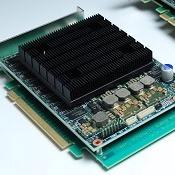Implementation and evaluation of data-compression algorithms for irregular-grid iterative methods on the PEZY-SC processor
- Naoki Yoshifuji (Fixstars)
- Ryo Sakamoto (Fixstars, present: PEZY Computing)
- Keigo Nitadori (RIKEN AICS)
- Jun Makino (Department of Planetology, Kobe University)
IA3 2016 Sixth Workshop on Irregular Applications: Architectures and Algorithms (SC16 Workshop) @ Salt Lake City, UT
Talk Summary
- HPCG was implemented on PEZY-SC on ZettaScaler system
- Single-chip performance of SpMV is 11.6 GFLOPS, which is 93% of the theretical limit determined by the memory bandwidth
- Simple and fast matrix compression were applied to SpMV and tested
- Data+Index table-based compression improved performance by a factor of 2.8
Data compression can be very powerful way to improve performance of unstructured grid calculation
Introduction
Contents
- Introduction
- PEZY-SC and ZettaScaler
- HPCG on PEZY
- SpMV with compression
- Conclusion
To solve linear equations
Many real problems (e.g. FEM or other CAE problems) requires to solve large linear equations:
\[A \boldsymbol{x} = \boldsymbol{b}\]
\(A\) is large sparse and irregular matrix in most cases of real problems
Iterative methods are suited
Multiplication of sparse matrix and vector (SpMV) is the most time-consuming process
SpMV is slow on modern HPC systems
| Rank | Computer | Rpeak | HPCG | HPCG/Rpeak |
|---|---|---|---|---|
| 1 | MilkyWay-2 | 54.9 | 0.58 | 1.1% |
| 2 | K computer | 11.3 | 0.55 | 4.9% |
| 3 | Sunway TaihuLight | 125.4 | 0.37 | 0.3% |
Modern computer's memory bandwidth is too small against (arithmetic) instruction throughput for SpMV
Our propposal
for sparse matrix
PEZY-SC and ZettaScaler
Contents
- Introduction
- PEZY-SC and ZettaScaler
- HPCG on PEZY
- SpMV with compression
- Conclusion
Why PEZY-SC?
- MIMD processor
→easy implementation - Byte per Flop is very small
→easy to check compression efficiency

HPCG on PEZY
Contents
- Introduction
- PEZY-SC and ZettaScaler
- HPCG on PEZY
- SpMV with compression
- Conclusion
Why HPCG?
- A standard benchmark for iterative method (MGCG)
- Its model is close to real problem (3D diffusion eq.)
Result of HPCG on PEZY
Achieved 168.06 GFLOPS with 8 nodes (32 PEZY-SCs)
SpMV analysis
93% of the theoretical limit
- Achieved
- 11.6 GFLOPS
- Theoretical by memory bandwidth
- 12.5 GFLOPS
SpMV with compression
Contents
- Introduction
- PEZY-SC and ZettaScaler
- HPCG on PEZY
- SpMV with compression
- Conclusion
Matrix in HPCG

- 2 same values
- Several same patterns for non-diagonal position
Matrix in real application
- Same coefficients
- If the physical characteristics of the material is uniform
- Same relative index pattern
- If we can use effectively regular grids for the bulk of the material
Table-based sparse matrix compression
- Data table compression
- extract same value of matrix elements
- Index table compression
- extract same pattern of column number
SpMV result on HPCG matrix
| Compression | Achieved GFLOPS | Theoretical GFLOPS | ratio (achieved/theretical) |
|---|---|---|---|
| None | 11.6 | 12.5 | x1.0 / x1.0 |
| Data table | 15.9 | 34.8 | x1.4 / x2.8 |
| Data+Index table | 32.4 | 326.0 | x2.8 / x26.1 |
NOTE: theoretical estimate ignores input vector random access
Conclusion
Contents
- Introduction
- PEZY-SC and ZettaScaler
- HPCG on PEZY
- SpMV with compression
- Conclusion
Conclusion
- HPCG was implemented on PEZY-SC on ZettaScaler system
- Single-chip performance of SpMV is 11.6 GFLOPS, which is 93% of the theretical limit determined by the memory bandwidth
- Simple and fast matrix compression were applied to SpMV and tested
- Data+Index table-based compression improved performance by a factor of 2.8
Compression technique will improve solver for linear equations in CAE application and others on the current and future HPC system!
Acknowledgment
- The authors would like to thank people in PEZY Computing/ExaScaler for their invaluable help in solving many problems we encountered while porting and tuning HPCG.
- Part of the research covered in this paper research was funded by MEXT’s program for the Development and Improvement for the Next Generation Ultra High-Speed Computer System, under its Subsidies for Operating the Specific Advanced Large Research Facilities.
- Workshop paper: http://conferences.computer.org/ia3/2016/papers/3867a058.pdf
- Full paper: https://arxiv.org/abs/1612.00530